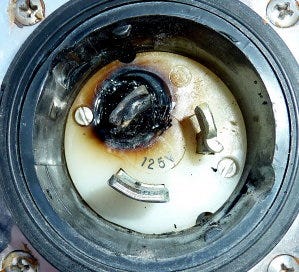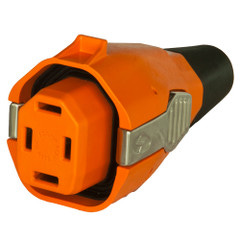Dear Readers,
As most of us are getting ready for the camping season, now is a great time to repair and upgrade your electrical systems. That way you won’t be caught off-guard when you head out on your first trip and forgot something important.
Email tales…
I’ve had dozens of emails over the last few months about shore power plug meltdown, many times during extreme hot spells. It’s obvious that running air conditioners and other appliances at the same time can stress your RV electrical system to the max. And if it’s not maintained properly you can have equipment meltdown. Of course, connectors are typically the weak link in the system, so if your shore power connectors aren’t perfect, then that’s going to be where the overheating occurs.
30-amp shore power
Something that seems to exhibit the most problems is the pedestal outlet for 30-amp shore power. Even though the plug looks much more robust than the 20-amp plug in your house, in reality it’s only rated for 50% more amperage, that is, 30 amps of current instead of 20 amps.
I’ve written many times about how the TT-30 plug’s similarity to a home 240-volt dryer outlet can cause residential electrician confusion. But today I’m going to focus on the other end of the shore power cord – the part that plugs into your RV.
Twist-lock connectors
These twist-lock connectors have been around for a long time, so they’re on millions of RVs. And they are indeed approved for use in this application. However, to function properly twist lock plugs must be connected properly using both hands, first locking in the connector itself, then spinning on the locking ring. Failure to follow these steps can result in a high-resistance connection which could lead to overheating during high-current situations (like running air conditioners and microwave ovens).
SmartPlug upgrades
Enter SmartPlug. This marine-grade inlet receptacle and matching shore power plug not only has 20 times the contact surface area of a traditional twist-lock connector on your RV, it’s also manufactured with marine-grade contacts and hooks up with a simple “push” and click. So there’s no additional alignment procedures, twisting motions to make full contact, or extra lock rings that must be spun on without cross-threading.
Yes, they make a 50-amp SmartPlug too!
Live, on TV, it’s me….
Click on the picture to watch my 7-minute video where I explore the differences between the standard twist-lock and SmartPlug connectors. And if you had any type of shore power connector failure last season, now is the time to consider an upgrade. Not much stops a camping trip faster than an electrical system failure.
Where to buy SmartPlugs (and lots of other RV stuff).
I’ve just started an affiliate program with TechnoRV which does pay me a small commission on products that you purchase from them. I’ve know Eric and Tami for years, and their customer service and educational programs are fantastic. That’s something you don’t get from Amazon or eBay (as much as I like both of them). So click the TechnoRV logo above or link below and take a look around. Many of their products were independently reviewed by me before they became dealers for them. For a direct link click HERE.
Let’s play safe out there…. Mike











I was going on 3-4 years thinking my twist lock was just fine! Well, the day came when I noticed burn/melt indications on the female end…and that was going on WHILE we were camping! No brainer. Got the Smart Plug! Easy DIY!
My RV is 11 years old and came with the 'old-fashioned' plug and cable that stores inside the trailer in a small box-like area near the outside rear of the trailer. I actually prefer this to the new version where you have a whole separate power cable that you have to find somewhere to store when traveling. I have another reason for preferring this setup but it would take up too much space to explain it.